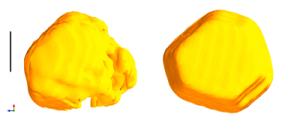The technique was first suggested in 1939 but wasn’t feasible until the advent of computers and their algorithms. Researchers at the University College of London have found a way to improve the quality of 3-D images of nanomaterials. From the Aug. 7, 2012 news release on EurekAlert,
A new advance in X-ray imaging has revealed the dramatic three-dimensional shape of gold nanocrystals, and is likely to shine a light on the structure of other nano-scale materials.
Described today in Nature Communications, the new technique improves the quality of nanomaterial images, made using X-ray diffraction, by accurately correcting distortions in the X-ray light.
Dr Jesse Clark, lead author of the study from the London Centre for Nanotechnology [at the University College of London] said: “With nanomaterials playing an increasingly important role in many applications, there is a real need to be able to obtain very high quality three dimensional images of these samples.
“Up until now we have been limited by the quality of our X-rays. Here we have demonstrated that with imperfect X-ray sources we can still obtain very high quality images of nanomaterials.”
You can see the differences for yourself in this image provided by the researchers,

Figure: Shown on the left is the three dimensional image of a gold nanocrystal obtained previously while on the right is the image using the newly developed method. The features of the nanocrystal are vastly improved in the image on the left. The black scale bar is 100 nanometres (1 nanometre = 1 billionth of a meter). Downloaded from http://www.london-nano.com/research-and-facilities/highlight/advance-in-x-ray-imaging-shines-light-on-nanomaterials
The researchers have also provided two videos, the first features the current standard 3-D image of a gold nanocrystal and the second features the improved image,
Standard 3-D
Improved 3-D
The Aug. 7, 2012 news release originated from an article (Aug. 2012?) by Ian Robinson and Jesse Clark for the London Centre for Nanotechnology (part of the University College of London) giving context for the research and describing the technique (Note: I have removed a link),
Up until now, most nanomaterial imaging has been done using electron microscopy. X-ray imaging is an attractive alternative as X-rays penetrate further into the material than electrons and can be used in ambient or controlled environments.
However, making lenses that focus X-rays is very difficult. As an alternative, scientists use the indirect method of coherent diffraction imaging (CDI), where the diffraction pattern of the sample is measured (without lenses) and inverted to an image by computer.
Nobel Prize winner Lawrence Bragg suggested this method in 1939 but had no way to determine the missing phases of the diffraction, which are today provided by computer algorithms.
CDI can be performed very well at the latest synchrotron X-ray sources such as the UK’s Diamond Light Source which have much higher coherent flux than earlier machines. CDI is gaining momentum in the study of nanomaterials, but, until now, has suffered from poor synchimage quality, with broken or non-uniform density. This had been attributed to imperfect coherence of the X-ray light used.
The dramatic three-dimensional images of gold nanocrystals presented in this study demonstrate that this distortion can be corrected by appropriate modelling of the coherence function.
Professor Ian Robinson, London Centre for Nanotechnology and author of the paper said: “The corrected images are far more interpretable that ever obtained previously and will likely lead to new understanding of structure of nanoscale materials.”
The method should also work for free-electron-laser, electron- and atom-based diffractive imaging.
That mention of the UK’s Diamond Light Source reminded me of the Canadian Light Source located in Saskatoon, Saskatchewan. I imagine this work will open up some possibilities for the researchers there.
For those who would like to read more about the work, here’s a citation for the article,
High resolution three dimensional partially coherent diffraction imaging, Nature Communications. J.N. Clark, X. Huang, R. Harder, & I.K. Robinson Nature Communications 3, Article number: 993 doi:10.1038/ncomms1994
This article is behind a paywall.